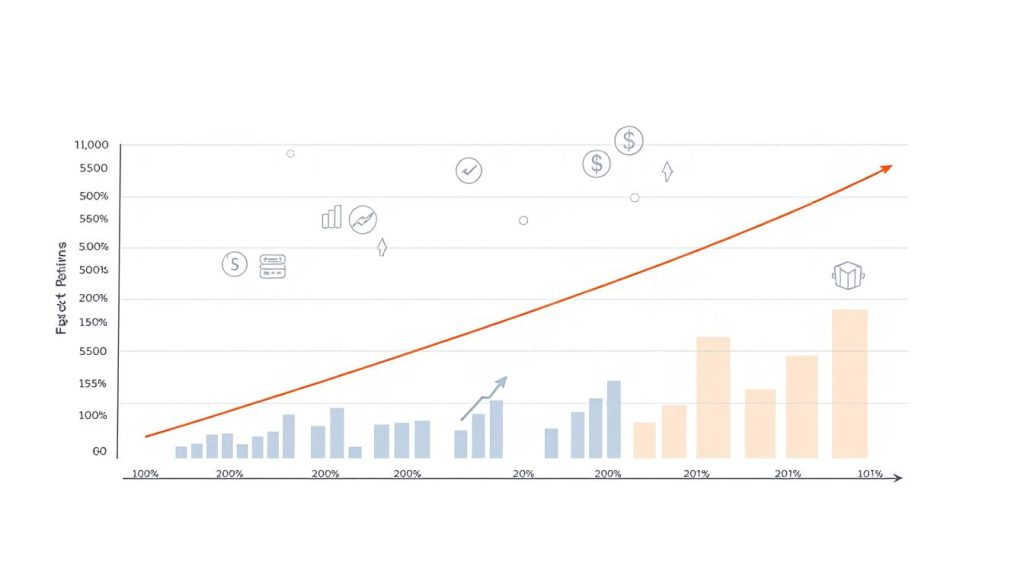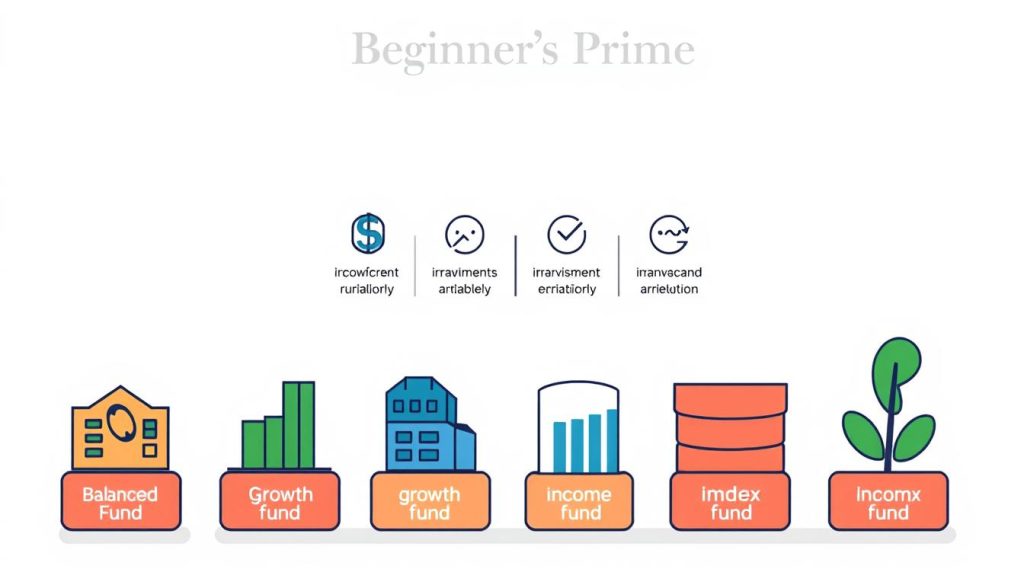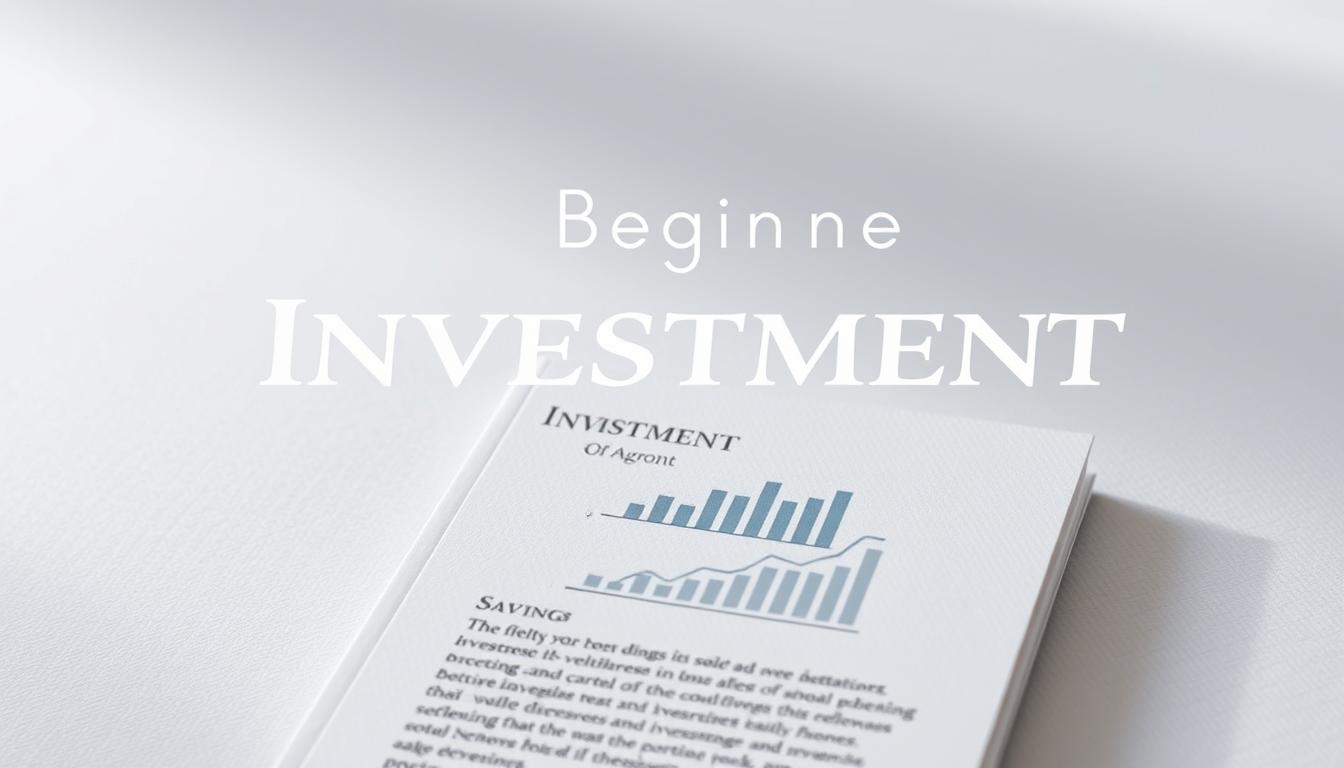Can investors achieve their financial goals without taking on excessive risk? This question is at the heart of every investment decision.
Investors constantly seek the perfect balance between risk and potential returns. Too much risk can lead to significant losses, while too little may result in missed opportunities.
Effective investment strategies and thorough financial planning are crucial in navigating this delicate balance.
Key Takeaways
- Investors must balance risk and potential returns to achieve their financial goals.
- Effective investment strategies are crucial in managing risk.
- Thorough financial planning helps investors make informed decisions.
- A well-diversified portfolio can help mitigate risk.
- Regular portfolio rebalancing is essential to maintaining an optimal risk-return balance.
The Foundation of Investment Success
Investment success is rooted in a deep understanding of the factors that influence risk and return. Investors must navigate a complex landscape of opportunities and challenges to achieve their financial goals.
Why Risk and Return Matter
Risk and return are the twin pillars of investment decision-making. Understanding why they matter is crucial for making informed choices. Risk assessment and risk management are essential for mitigating potential downsides, while investment returns are the rewards for taking calculated risks.
The Fundamental Relationship Between Risk and Reward
The relationship between risk and return is fundamental to investing. Generally, investments with higher potential returns come with higher levels of risk. This tradeoff is critical to understand when constructing a portfolio.
| Investment Type | Risk Level | Potential Return |
|---|---|---|
| Stocks | High | High |
| Bonds | Medium | Medium |
| Cash Equivalents | Low | Low |
Understanding Risk and Return
Understanding the dynamics between risk and return is crucial for making informed investment decisions. Investors need to comprehend how different investments carry varying levels of risk and potential return to make choices that align with their financial goals.
Defining Investment Risk
Investment risk refers to the likelihood that an investment’s actual return will differ from its expected return. Risk can result in losses or reduced gains, making it a critical factor to consider.
Systematic vs. Unsystematic Risk
Systematic risk, also known as market risk, affects the entire market and cannot be diversified away. Unsystematic risk, on the other hand, is specific to individual investments and can be mitigated through diversification.
Types of Investment Returns
Investment returns can be categorized into two main types: income and capital appreciation. Income returns include dividends and interest payments, while capital appreciation refers to the increase in an investment’s value over time.
Income vs. Capital Appreciation
Investors may prioritize income returns for regular cash flow or capital appreciation for long-term growth. A balanced approach can provide both income and capital appreciation.
The Risk-Return Tradeoff
The risk-return tradeoff is a fundamental principle in investing: higher potential returns typically come with higher risk. Understanding this tradeoff is essential for making informed investment decisions.

Assessing Your Risk Tolerance
Assessing personal risk tolerance is a fundamental step in creating a tailored investment strategy. It involves understanding your ability to withstand market fluctuations and make informed decisions that align with your financial goals.
How to Evaluate Your Personal Risk Capacity
Evaluating your risk capacity involves two key assessments: your financial situation and your psychological comfort with market volatility.
Financial Situation Assessment
Consider your income stability, expenses, debts, and overall financial health. A stable financial foundation can increase your risk capacity.
Psychological Comfort with Volatility
Assess how you react to market downturns. If you are prone to making impulsive decisions during volatility, you may need to adjust your investment strategy to a more conservative approach.
Matching Time Horizon to Risk Level
Your investment time horizon plays a crucial role in determining your risk level. A longer time horizon generally allows for a higher risk tolerance, as there’s more time to recover from market downturns.
Practical Tools for Measuring Risk Tolerance
Several online questionnaires and risk assessment tools can help quantify your risk tolerance. These tools consider factors like your investment goals, time horizon, and comfort with risk to provide a personalized risk profile.
By understanding your risk tolerance, you can make more informed investment decisions that balance potential returns with your personal comfort level, ultimately leading to a more effective financial planning strategy.
Key Investment Risk Factors to Consider
Several critical risk factors can affect investment performance, and it’s essential to identify and manage them effectively. Investors must be aware of these factors to make informed decisions that align with their financial goals.
Identifying and Managing Market Risk
Market risk is the possibility that an investment’s value will decrease due to market fluctuations. To manage market risk, investors can diversify their portfolios across different asset classes, such as stocks, bonds, and real estate.
Protecting Against Inflation Risk
Inflation risk occurs when the purchasing power of money decreases over time. Investors can protect against inflation risk by investing in assets that historically perform well during periods of inflation, such as commodities or Treasury Inflation-Protected Securities (TIPS).

Addressing Liquidity Concerns
Liquidity risk is the risk of being unable to sell an investment quickly enough or at a fair price. Investors can mitigate liquidity risk by maintaining an emergency fund and investing in liquid assets.
Mitigating Concentration Risk
Concentration risk arises when a portfolio is overly invested in a single stock, sector, or geographic region. To mitigate this risk, investors can diversify their portfolios across various sectors and geographic regions.
| Risk Factor | Mitigation Strategy |
|---|---|
| Market Risk | Diversification across asset classes |
| Inflation Risk | Investing in inflation-protected assets |
| Liquidity Risk | Maintaining an emergency fund |
| Concentration Risk | Diversification across sectors and regions |
By understanding and addressing these key investment risk factors, investors can better manage their portfolios and work towards achieving their long-term financial objectives.
“Diversification is the only free lunch in finance.” – Harry Markowitz
Effective Risk Management Techniques
To achieve investment success, understanding and implementing effective risk management techniques is essential. This involves a multi-faceted approach that includes diversification, asset allocation, and regular portfolio rebalancing.
How to Implement Diversification Strategies
Diversification is a key risk management technique that involves spreading investments across different asset classes to reduce exposure to any one particular market. Diversification benefits include reduced volatility and potentially higher returns over the long term.
Across Asset Classes
Investing across various asset classes such as stocks, bonds, and real estate can help mitigate risk. For example, during economic downturns, bonds may perform better than stocks, cushioning the impact on a portfolio.
Within Asset Classes
Within asset classes, diversification can be achieved by investing in different sectors or geographic regions. For instance, within the stock market, investing in both technology and healthcare sectors can reduce dependence on a single industry.
Applying Asset Allocation Principles
Asset allocation strategies involve dividing investments among different asset categories based on an investor’s risk tolerance, time horizon, and financial goals. This strategic allocation is crucial for managing risk and achieving consistent returns.
When and How to Rebalance Your Portfolio
Regular portfolio rebalancing is necessary to maintain the desired asset allocation as market fluctuations can cause portfolios to drift from their original targets. Rebalancing involves buying or selling assets to return to the original allocation, ensuring that the portfolio remains aligned with the investor’s risk tolerance and investment objectives.
Analyzing Expected Returns
To maximize investment returns, it’s essential to understand how to analyze expected returns effectively. This involves evaluating historical performance, developing return projections, and adjusting expectations based on risk.
Steps to Evaluate Historical Performance
Evaluating historical performance is the first step in analyzing expected returns. Investors should review past returns over various time frames to identify trends and patterns. This helps in understanding how different assets have performed under various market conditions.
Methods for Developing Return Projections
Developing return projections involves using historical data, economic indicators, and market analysis to forecast future returns. Investors can use statistical models and expert forecasts to make informed predictions.
How to Adjust Return Expectations for Risk
Adjusting return expectations for risk is crucial. Risk-adjusted return metrics help investors understand the return per unit of risk taken. One common metric is the Sharpe Ratio.
Risk-Adjusted Return Metrics
Risk-adjusted return metrics provide a more nuanced view of investment performance. The Sharpe Ratio, for instance, measures the excess return over the risk-free rate, relative to its volatility.

| Metric | Description | Usefulness |
|---|---|---|
| Sharpe Ratio | Measures excess return over risk-free rate relative to volatility | High |
| Sortino Ratio | Similar to Sharpe Ratio but focuses on downside risk | High |
| Treynor Ratio | Measures excess return per unit of market risk | Moderate |
Building a Balanced Portfolio
Building a balanced portfolio requires a thoughtful approach to asset allocation and risk management. It’s about creating a mix of investments that aligns with your financial goals and risk tolerance.
Creating Your Strategic Asset Allocation
A strategic asset allocation involves dividing your investments among different asset classes, such as stocks, bonds, and real estate. This diversification helps manage risk and can improve potential returns.
- Stocks for long-term growth
- Bonds for income and stability
- Real estate for diversification and potential long-term appreciation
Making Tactical Adjustments
Tactical adjustments involve making temporary changes to your asset allocation based on market conditions. This can help you capitalize on opportunities or mitigate potential losses.
“The biggest risk is not taking any risk…” – George Bernard Shaw
Step-by-Step Implementation Guide
Setting Up Your Investment Accounts
Start by opening the necessary investment accounts, such as a brokerage account or IRA.
Selecting Appropriate Investment Vehicles
Choose investments that align with your asset allocation strategy, such as index funds, ETFs, or individual stocks and bonds.
Establishing a Monitoring System
Regularly review your portfolio to ensure it remains aligned with your investment objectives. Rebalance as necessary to maintain your target asset allocation.
By following these steps, you can create a balanced portfolio that helps you achieve your financial goals while managing risk.
Conclusion: Maintaining Balance Through Market Cycles
Maintaining a balanced investment portfolio is crucial for navigating various market cycles. Effective risk management is key to achieving this balance, as it enables investors to mitigate potential losses and capitalize on opportunities. By understanding the relationship between risk and return, investors can make informed decisions that align with their financial goals.
A well-structured financial planning process involves assessing risk tolerance, diversifying investments, and regularly reviewing portfolio performance. This approach helps investors stay on track, even during periods of market volatility. By incorporating a range of investment strategies, investors can optimize their returns while minimizing risk.
Ultimately, a balanced investment portfolio is one that is tailored to an individual’s unique financial situation and goals. By applying the insights and principles outlined in this article, investors can create a robust investment plan that withstands market fluctuations and supports long-term financial success.
FAQ
What is the risk-return tradeoff in investing?
The risk-return tradeoff is a fundamental principle in investing that suggests that higher potential returns are associated with higher levels of risk. Investors must balance their desire for returns with their tolerance for risk.
How do I assess my personal risk tolerance?
Assessing your risk tolerance involves evaluating your financial situation, understanding your psychological comfort with market volatility, and matching your investment time horizon to an appropriate risk level. You can use online risk tolerance quizzes or consult with a financial advisor to help determine your risk capacity.
What is diversification, and how can it help manage risk?
Diversification is an investment strategy that involves spreading investments across different asset classes, such as stocks, bonds, and real estate, to reduce risk. By diversifying your portfolio, you can minimize the impact of any one particular investment on your overall returns.
What are some common investment risk factors that I should be aware of?
Common investment risk factors include market risk, inflation risk, liquidity risk, and concentration risk. Understanding these risks can help you make informed decisions and develop strategies to mitigate potential downsides.
How often should I rebalance my investment portfolio?
The frequency of rebalancing depends on your investment strategy and market conditions. Some investors rebalance their portfolios on a regular schedule, such as quarterly or annually, while others rebalance when their asset allocation deviates from their target by a certain percentage.
What is asset allocation, and why is it important?
Asset allocation is the process of dividing your investments among different asset classes, such as stocks, bonds, and cash. It is a critical component of investment planning, as it can help you manage risk and achieve your long-term financial goals.
How can I evaluate the historical performance of an investment?
Evaluating the historical performance of an investment involves analyzing its returns over time, as well as its volatility and other risk metrics. You can use online resources, such as financial databases or investment websites, to access historical performance data.
What are risk-adjusted return metrics, and how are they used?
Risk-adjusted return metrics, such as the Sharpe ratio, are used to evaluate the performance of an investment relative to its risk. These metrics can help you compare the risk-adjusted returns of different investments and make more informed decisions.













